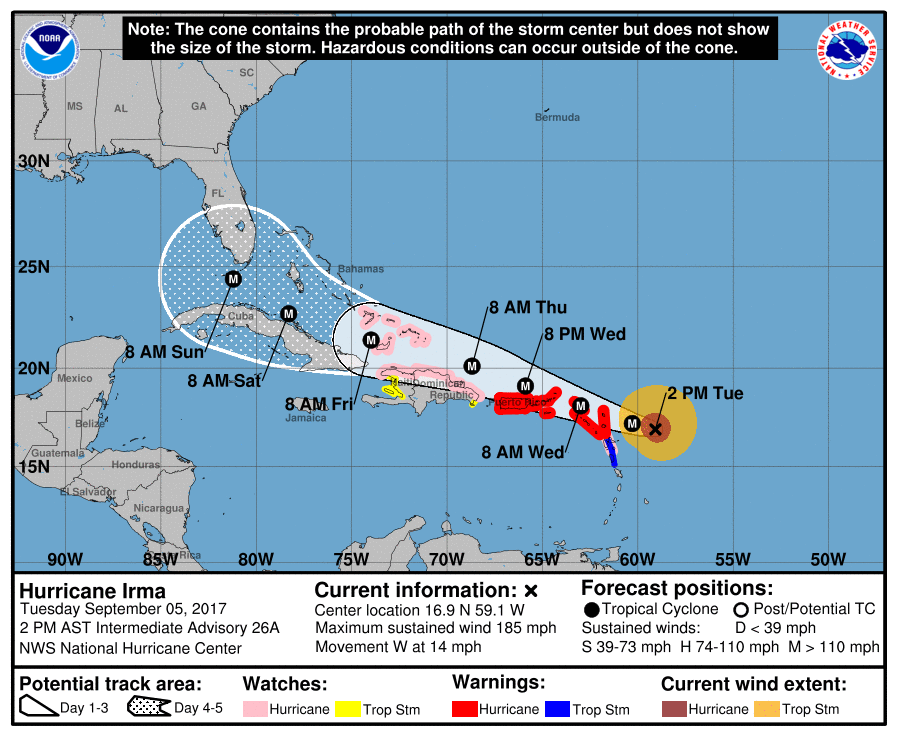- April 19, 2024
-
-
Loading

Loading

Sarasota County could expect to feel the effects of Hurricane Irma as early as Friday evening, according to Sarasota County Emergency Management Chief Ed McCrane.
In a news conference the afternoon of Sept. 5, he cautioned residents to start preparing now, and gave a picture of what to expect.
Based on Sarasota’s position in the state, there are several counties that are farther south that have less time to plan. Those counties are already asking visitors and tourists to leave, meaning Sarasota will see a lot of travelers passing through as they evacuate.
“We have to take into consideration that we are going to have residents of the state of Florida moving north, moving into our area, seeking safe places to stay. So that puts us in a host capacity, like we did for Hurricane Matthew,” he said. He asked residents to find alternate routes to work or their homes that avoid the interstate.
County staff members are considering all possible outcomes for the “unpredictable storm,” which is currently a Category 5 hurricane south of the U.S. According to McCrane, the best possible outcome — that Irma moves off into the Atlantic and doesn’t affect the area at all — is unlikely. The other scenario is that the storm comes up the middle of Florida, or up the east coast. The worst possible scenario for Sarasota would be that it moves north along the west coast.
In that case, emergency managers expect anywhere from 6-15 feet of storm surge, which would prompt evacuations in the county. And McCrane said, based on the size of this storm, even if Irma moves up the east coast of Florida, a 6-foot storm surge could still be expected for the west coast.
“There’s no need to panic. We will get through these storms. This is not Harvey,” he said. “This is probably going to be a fast-moving, large hurricane zipping up the coast.”
A potential problem for residents who are preparing for the storm is the proximity of Hurricane Irma to Hurricane Harvey, which devastated areas of Texas just more than a week ago. Resources from the Red Cross, FEMA and the federal government were directed there, so items like sandbags must be sourced from other parts of the U.S.
“They understand that we have a dire situation,” McCrane said of emergency organizations. “We are going to deal with what we have.”
The county will hand out sandbags on Sept. 6 at three locations throughout the county from 8 a.m.-4 p.m. The limit is 15 bags per household, while supplies last.
Bags were handed out last weekend to help residents deal with localized flooding, and McCrane encourages those bags be reused, or residents to make do with pillowcases or mulch bags if they can’t get actual sandbags. Residents can get free sand to fill their own bags at Big Earth Landscape Supply, at 6625 Bee Ridge Road, Sarasota.
Further, after last week’s heavy rainfall produced flooding in parts of the county, McCrane said many of the county’s rivers, retention ponds and lakes are full.
“It’s making it a little bit more difficult because all of the retention ponds, waterways and rivers are at capacity,” he said. “Any additional water could cause those problems again.”
Additionally, the county’s water treatment facilities can become overburdened and start overflowing if too many people are using water and there’s too much rainfall.
However, McCrane said the county’s stormwater system did a great job in most casts, although some areas were overwhelmed quickly. He called the last week’s rain in Sarasota “historic,” and claimed it would have been national news if Harvey hadn’t happened at the same time.
“Run from the water, hide from the wind.”
That’s what McCrane said is the key to surviving hurricane impacts.
“All you have to do is go tens of miles, not hundreds of miles.”
Though many people will feel the need to evacuate, McCrane said if you’re not in an emergency evacuation zone, you have the supplies you need and you are confident your home or structure can withstand hurricane conditions, you can stay. Those who should get out are people in mobile homes, those who are concerned about getting the medical attention they need consistently or those who have concerns about the safety of the building they’re in.
If people do evacuate, McCrane said, “I-75 will become a parking lot.” He encouraged residents to find alternate routes to get north.
As far as timing goes, the farther you plan to travel, the sooner you should leave. McCrane recommends staying with friends or family if there’s a safe place you can be, or finding a hotel. Reservations should be made as soon as possible, he recommended, and he said it’s important to ask if the hotel is in an evacuation zone, what services they will provide, if it will be staffed, etc.
Residents who evacuate should take their supplies with them, especially if they’re going to a county shelter. Although the county has 22 shelters available, it is likely that only a few will be opened. When that is announced, residents should be prepared to go to a location that may not be in their own neighborhood.
“The storm is coming,” McCrane said. “It’s far out still. We have a long time to wait, but we have a long time to get things in order.”